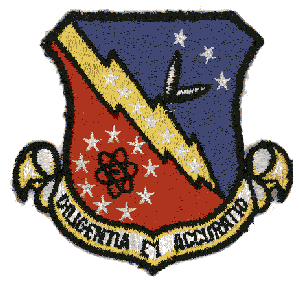 |
379th Bombardment Wing Insignia
|
The 379th Bombardment Wing traces its history back to 1942 when the 379th
Bombardment Group was established November 3rd at Gowen Field, Boise, Idaho. For
the first four months it was occupied with flight training in the B-17. On May
1943, the 379th Bomb Group was assigned to Kimbolton, England, where it was
stationed for the next two years.
The group was awarded the Distinguished
Unit Citation for its raid on Oschersleben, Germany, Jan. 11, 1944, and a
second award on the citation for "extraordinary heroism, determination and
'esprit de corps' in action against the enemy from May 29, 1943 to July 31,
1944".
The 379th Bomb Group also earned seven battle credits during its 23 months of
combat. On July 15, 1945, the 379th, by then transferred to Air Transport
Command, was deactivated at Casablanca, Morocco.
In 1954, Strategic Air Command and North American Aerospace Defense Command
(then Air Defense Command) asked Headquarters U.S. Air Force to perpetuate the
histories and honors of World War II combat groups. Headquarters studied the
request and, in 1954, agreed to bestow on SAC Wings, created during or after
1947, the honors and history of those bombardment groups with the same numerical
designation.
Therefore, when the 379th Bombardment Wing was constituted and activated Nov.
1, 1955, at Homestead AFB, Fla., it inherited the honors, history and colors of
the old 379th Bomb Group.
During the first five months, the 379th BMW concentrated on the manning and
equipping of the unit and formulated a training schedule on April 20, 1956.
Beginning in mid 1957, the wing deployed aircraft, crews, and support personnel
to North African bases under the REFLEX ACTION program. This requirement
continued throughout the rest of the wing's assignment at Homestead AFB. The
379th Combat Support Group, including six squadrons bearing the same numerical
designation, was organized for the wing April 1, 1960, and during that same
year, the 920th Air Refueling Squadron was transferred from Carswell AFB, Texas,
to Wurtsmith, flying the KC-135A Stratotanker.
On Jan. 9, 1961, the 379th BMW transferred to Wurtsmith AFB and changed its
designation to heavy bombardment wing. Four months after the transfer, the wing
received its first B-52H bomber, number 60-00001, the first "H" model B-52
assigned to SAC. The aircraft was christened "The State of Michigan" during
ceremonies on the Wurtsmith flight line on May 11, 1961.
After five months of intensive training, the wing was declared combat-ready
in early October 1961. At the same time, the wing received its first AGM-28B
"Hound Dog" missiles.
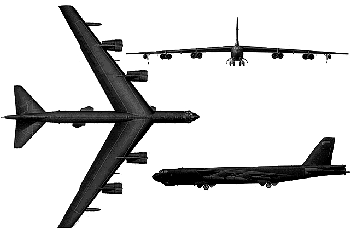
In 1969, 379th BMW aircrews once again saw combat as the "ARC Light" program
came to Wurtsmith. This program included cross-training to "D" model B-52s and
flying combat missions in Southeast Asia.
Members of the 920th Air Refueling Squadron participated in "Young Tiger"
operations during this period, providing air refueling support to these
missions.
December 1972 saw many of the same crews involved in the "Eleven Day War"
with North Vietnam.
The 379th developed an operational short range attack missile (SRAM)
capability in April 1974, and since then has achieved superior results during
the "Bullet Blitz" follow-on tests and evaluations of the SRAM system.
The wing completed a major B-52 aircraft conversion in July 1977, resulting
in the transfer of the wing's "H" models for "G" models from Ellsworth AFB, S.D.
The accelerated copilot enrichment (ACE) program began in October 1977,
following the assignment of five T-37 aircraft to Wurtsmith.
In April 1983, modifications were completed on Wurtsmith B-52s to support the
Air Launched Cruise Missile, which continues to help the wing meet its
challenges of deterrence and peace.
Adding to the many awards and honors in the 379th BMW's history, the wing's
members blasted units from throughout SAC in November 1987 during the command's
Bombing and Navigation Competition at Barksdale AFB, La. The 379th won the
coveted Fairchild Trophy, recognizing the best bomber/tanker unit; the Curtis E.
LeMay Bombing Trophy for the crew with the best high- and low-level bombing; and
there other trophies, the Mathis, the John D. Ryan B-52; and the William J.
Crumm Linebacker Memorial, were awarded for excellence in high- and low-level
bombing.
The last B-52 left the site of Wurtsmith Air Force Base in July of 1993.
History of the 379th Bombardment Group
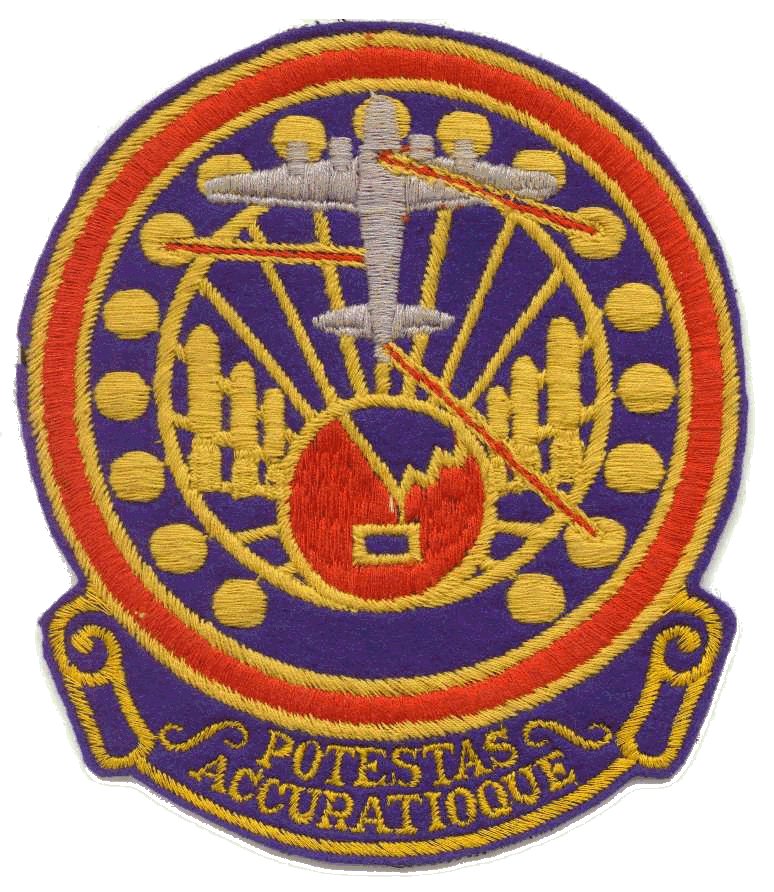
The 379th Bombardment Group was in activation for only 2 years, 7 months, and
29 days. From November 26, 1942, at Gowen Field, Boise, Idaho, until July 25,
1945, at Casa Blanca, Africa. During that time the 379th received two Distinguished Unit Citations. The first one
for the January 11, 1944, mission to Oschersleben for which the entire First
Bomb Division was cited, and the second for "extraordinary heroism,
determination, and esprit de corps in action against the enemy from 29 May,
1943, to 31 July, 1944."
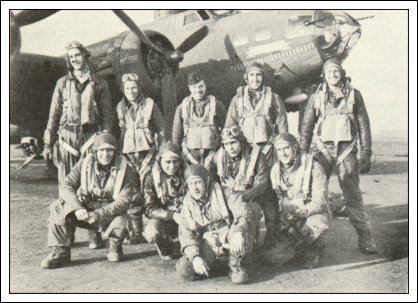
A B-17 Crew
The orange circle represents the Rising Sun of Japan; immediately next to
that circle is a sundial - when reading a sundial, start at the top of the clock
at 12, then read clockwise 1,2,3, etc., then start at the top of the clock again
and read counter clockwise, 12, 11, 10, 9, etc.; the top-turret guns of the B-17
are firing at the 3 in the sundial, the tail guns at the 7, and the left waist
guns at the 9, which gives you the designation 379; the bombs indicate that of a
bomb group; and the B-17 is , of course, the plane used in operation; the inner
circle of orange represents Hitler - the zig-zag line is for the lock of hair
that always fell over Hitler's left eye, and the black square in the center is
his moustache; "Potestas Accuratioque" means "Power and Precision."
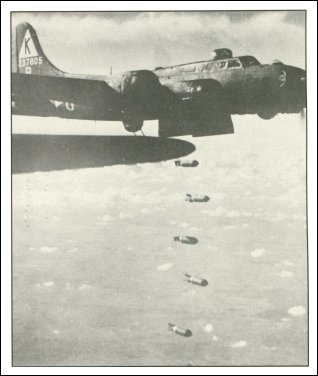
Carol Dawn delivers her load
The 379th was credited with more sorties than any other group in the Eighth
Air Force, had a lower loss rate than that of any B-17 group which was in the
war from 1943 on, and had a lower abortive rate for the entire period of the war
than that of any comparable unit. In April of 1944, the 379th attained an
operational "grand slam" with the best bombing, greatest tonnage, greatest
number of aircraft attacking, lowest losses and lowest abortive rate of all
units in the Eighth Air Force. They bombed with greater over-all accuracy than
any other group in the First Air Division, dropped a greater tonnage of bombs
during any single month of 1944 and 1945 than any other group.
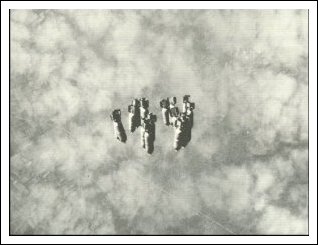
Bombs Away!
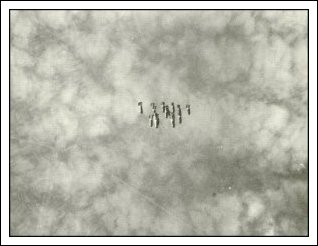
The target is a factory at Ludwigshaven

The Aftermath
AAF Station 117 - Kimbolton
Originally build for use by RAF bombers in 1941 this airfield had a main
runway of only 1,340 yards and 30 aircraft hardstands. The main runway was
extended to 2,000 yards making it a Class A airfield and 20 additional
hardstands were build increasing the number to 50. Additional living sites were
built with the majority of the personnel accommodations being to the south of
the airfield close to the adjacent town of Kimbolton.
The first unit to occupy Station 117 was the USAAF 91st Bombardment Group
which arrived fresh from the States in September 1942. But the 91st moved to
Bassingbourn after only a month because the runways were not strong or long
enough for the safe operation of the B-17 Flying Fortress. The 17th Bombardment
Group, operating the B-26 Marauder took over residency at the station, but again
stayed for only one month at with time the unit was transferred to Africa.
Improvements were made to the field to facilitate the operation of
fully-loaded B-17s readying Station 117 for its new occupants, the most
successful of all the Eighth Air force heavy bomber groups, the 379th.
Hanger accommodations at Kimbolton were provided by the standard two T2s
dispersed on the western and southern sides of the airfield.
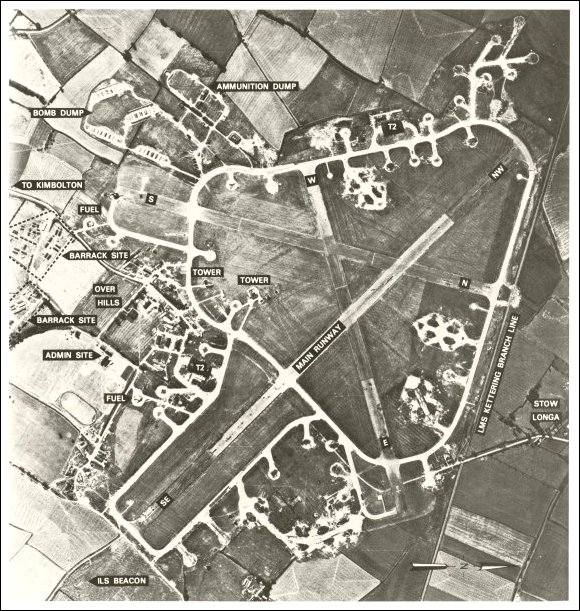
379th Bomb Group Original Assignment Aircraft
|
Activation:
3rd
November 1942
Squadrons:
524th,
525th, 526th, 527th
Command:
Eighth Air
Force
Command Wing:
First
Bombardment Wing
Combat Wing:
103rd
Provisional bombardment - May 1943
41st Combat Bombardment - 16th September
1943
Stations:
Bovingdon
- Air Echelon in 26th April 1943
Kimbolton - Air Echelon in May 1943, Ground
Echelon in 19th May 1943
|
Aircraft Assignments
The
following aircraft constitute the original B-17Fs assigned the the 379th
Bombardment Group in Sioux City, Iowa between approximately the 16th and 20th of
March 1943.
|
| 42-3099 |
42-5809 |
42-29772 |
42-29875 |
42-29891 |
| 42-3113 |
42-5813 |
42-29773 |
42-29876 |
42-29892 |
| 42-3114 |
42-5816 |
42-29829 |
42-29878 |
42-29893 |
| 42-3132 (2) |
42-5821 |
42-29830 |
42-29879 (1) |
42-29896 |
| 42-3138 |
42-5822 |
42-29864 |
42-29886 |
42-29898 |
| 42-3143 (3) |
42-5827 |
42-29866 |
42-29889 |
42-29901 |
| 42-3145 |
42-5828 |
42-29869 |
42-29890 |
42-29942 (4) |
| 42-3148 |
42-5929 |
42-3154 |
42-5830 |
|
|
(1) 42-29879: Wrecked at Kearney about 9 April 1943 (not
to UK)
(2) 42-3132: Lost in Atlantic Ocean, 23 April 1943
(3) 42-3143:
Crashed in Northern Ireland on arrival from Gander
(4) 42-29942: Crashed
landing at Prestwick at end of Transatlantic ferry flight
NOTE: Only 39
aircraft are listed, there is possibly one more that could not be
located.
|